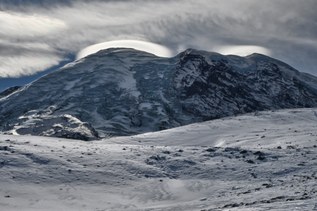Start your hike by following a nice gravel path past an old trailhead and down toward the river. The gravel ends and the old railroad grade begins, now a wide flat trail through an old second-growth forest of hemlock and sword fern. There is an interpretive sign here detailing the logging and railroad history of this area. Everywhere there is soft green moss, carpeting the forest floor, on the branches of trees and covering old stumps left from long-ago logging. In the fall, the understory of vine and bigleaf maple brighten the trail with gold and red.
The forest opens in a half mile, and you are above the river with a nice view out towards the peaks of the Mountain Loop. As you follow along the bank, the trail sometimes succumbs to the same forces of nature as the railroad did, and small slides and washouts periodically occur in this section. There are two large logs to crawl over, made much easier by foot and hand holds cut into the log. At about a mile in, there is one short switchback that leads to the water's edge. Here, look for spawning salmon in fall and eagles in winter.
The trail then leaves the fast-flowing river and skirts along the marshy areas and standing water of the old river channel. Enjoy the charming old moss-covered bridges crossing over the small creeks and through the mud. Be careful though, they can be slick, and the wood is rotting away. In the spring, the bright yellow spathe flowers of skunk cabbage, or, as some prefer to call it, swamp lanterns will light up the muddy water. If you are willing to get your boots muddy, bend down and look closely at the flower shape. The true flowers are on the spike, the bright yellow that draws our eye is the bract. See if you can find pollinating insects on the small flowers. After the bloom is over the leaves continue to grow and get quite large.
After winding through the marsh, come to the remnants of an old bridge, now demolished by a large blowdown. The bridge is now a viewpoint, and the trail now ends here at one and a half miles. You can find old beaver dams — they will look like long piles of sticks with grasses growing on top. Listen for birdsong and watch the water for small amphibians rising to the surface to feed on insects. There are some flat spots close by for a shady lunch, or as you make your way back to the trailhead, find a spot where you can easily sit by the river.
This trail used to go further past the bridge and along the river, then head back up to the highway until a large slide took it out. The southern end is still there, but unmaintained. Now called the Lookout Tree trail, you can find it in just over 2 miles further south from the Beaver Lake trailhead along the Mountain Loop Highway. Look for an old brown hiker sign on the right side of the road. There is no trailhead parking. The trail — if you can find it — heads down steeply to an old cedar tree used as a fire lookout long ago. Just before a huge blowdown, find the tree on your right. A sign marking it may (or may not) be there.
extending your hike
Opportunities for exploring the old railroad grade can be found by hiking the Old Government trail at Barlow Pass. It starts at the same trailhead as Barlow Point.







 Trailhead
Trailhead





